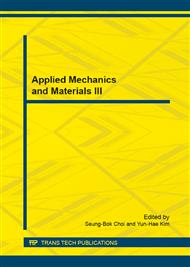[1]
Shi Huaqiang, Zongzhi, JiaXinbei. The far-field underwater explosion shock wave characteristics[J]. Explosion and Shock Waves, 2009(2): 125-130.
Google Scholar
[2]
Andrzej. G, Bogdan. S. Impact Modeling of Underwater Explosion[M]. Advances in MechatroincSystems, Mechanics and Materials, (2013).
Google Scholar
[3]
K. Spranghersa, I. Vasilakosa, D. Lecompteb, H. Sola, J. Vantommeb. Numerical simulation and experimental validation of the dynamic response of aluminum plates under free air explosions[J]. International Journal of Impact Engineering, April 2013(54): 83-95.
DOI: 10.1016/j.ijimpeng.2012.10.014
Google Scholar
[4]
Li Jian, RongJili. Experimental research and numerical simulation of Underwater Explosion's Dynamic Response [J]. European Journal of Fluid Mechanics, 2012(32): 59-69.
Google Scholar
[5]
G. Taylor. The pressure and impulse of submarine explosion waves on plates[M]. Cambridge University Press, Cambridge, UK, (1963).
Google Scholar
[6]
Bockstemer G. Evaluation of Underwater Explosive Performance of PBXW-115(AUST)[R]. 1996, DSTO-TR-0297.
Google Scholar
[7]
Jing Ping Lu, DavideL Kennedy. Modeling of PBXW-115 Using Kinetic CHEETAH and DYNA Codes[R]. 1996, DSTO-TR-1496.
Google Scholar
[8]
SHI Hua-qian, ZONG Zhi, JIA Jing-bei. Near field characteristics of the underwater explosion shock wave[J]. Explosion and Shock Waves, 2009, 29(2): 125-130.
Google Scholar
[9]
Ghoshal, Ritwik, Mitra, Nilanjan. Non-contact near-field underwater explosion induced shock-wave loading of submerged rigid structures: Nonlinear compressibility effects in fluid structure interaction[J]. Journal of Applied Physics, 112, 024911 (2012).
DOI: 10.1063/1.4737778
Google Scholar
[10]
ZHOU Lin, XU Shao-lin, XU Geng-guang. Explosive energy output characteristic research of underwater explosion[J]. Journal of China Ordnance, 2006, 27, (2): 235-238.
Google Scholar
[11]
ZhouLin, Xie, Zhongyuan, WeiXuexia. Comparison of underwater shock wave attenuation of a new insensitivehigh explosive with different explosives[J]. Combustion Explosion and Shock Wave, 2011, 47(6): 721-726.
DOI: 10.1134/s0010508211060153
Google Scholar
[12]
MiaoQS, XuGG, Wang TZ. Study on the underwater explosion performance of aliminized explosives [A]. Theory and Practice of Energetic Materials[C], 2001, 1(4): 342-346.
Google Scholar
[13]
Huang H. Transient bending of a large elastic plate by an incident spherical pressure wave[J]. Journal of Applied Mechanics, 1974, 41(3): 772-776.
DOI: 10.1115/1.3423386
Google Scholar


